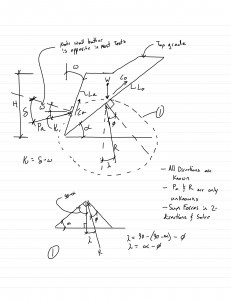Trial Wedge Method
Update: I will be updating this post or possibly creating a new post that demonstrates a simpler, clearer way to implement the trial wedge method. It should be completed by 2013/2/17.
Update: I realized a couple of algebra errors were made and now the spreadsheet should be functioning correctly. I have verified with Keystone’s Retaining Wall Software “Keywall” (its free upon request). I still have the “CT” equations as well which could be deleted as they are there for comparison. I believe the results are different because I derived my equations with a different geometry. I will also try to post hand calc example as well.
Trial Wedge Spreadsheet (Use RSF Equations)
Trial Wedge Method Video (coming soon)
There are many graphical solutions to the trial wedge analysis shown in textbooks however I was not pleased with them. They usually use ‘force polygons’ where you have to find the weight of each soil wedge for all the different failure angles. So given that this is an iterative process I thought excel would be a good tool. It turns out the trig/algebra/geometry is time consuming but I think I have the basics pretty close. Please check carefully for errors as there are many places for them to occur, please let me know what you find.
The calculation is limited to the geometry of which I selected – a flat section behind the wall, and a broken back slope.
However the procedure is applicable to any geometry. I hope to add the option of a water table elevation in the future.
Nomenclature:
Geometry:
H = Height of the retaining wall
h0 = Height from the bottom of the wall to h2
h1= Height of the brocken backslope
h2= Height from the top of wall to where the extension of the brocken backslope intersects the wall
h3 = Height from h0 to the intersection of the failure plane and the ground in section 2.
h4 = Height above the top of wall to the top of the broken back slope.
alpha = α = angle of failure plane measured CCW from the horizontal.
beta = β = angle of the broken back slope.
omega = ω = wall battered measured CW from the vertical.
Forces
Ca = Adhesion
Co = Coheasion
La = Length of adhesion
Lo = Length of cohesion
Ka, Kah, Kav = Active pressure coefficient, horizontal component and vertical component
Pa, Pah, Pav = Active force on retaining wall, horizontal component and vertical component
R, Rh, Rv = Resultant force of soil wedge weight and friction force direction is determined by effective friction angle and magnitude by the weight of the soil, horizontal component and vertical component
delta = δ = wall friction angle (effective friction angle between soil and wall)
phi = φ = effective friction angle of soil
kappa = κ = δ – ω
lambda = λ = α – φ
